

Venus is the second planet from the Sun, orbiting it every 224.7 Earth days. The planet is named after Venus, the Roman goddess of love and beauty. After the Moon, it is the brightest natural object in the night sky, reaching an apparent magnitude of -4.6, bright enough to cast shadows. Because Venus is an inferior planet from Earth, it never appears to venture far from the Sun:. Venus reaches its maximum brightness shortly before sunrise or shortly after sunset, for which reason it has been known as the Morning Star or Evening Star.
Venus is classified as a terrestrial planet and it is sometimes called Earth's "sister planet" due to the similar size, gravity, and bulk composition. Venus is covered with an opaque layer of highly reflective clouds of sulfuric acid, preventing its surface from being seen from space in visible light. Venus has the densest atmosphere of all the terrestrial planets in our solar system, consisting mostly of carbon dioxide.
Venus has no carbon cycle to lock carbon back into rocks and surface features, nor does it seem to have any organic life to absorb it in biomass. A younger Venus is believed to have possessed Earth-like oceans, but these evaporated as the temperature rose. Venus's surface is a dusty dry desertscape with many slab-like rocks, periodically refreshed by volcanism. The water has most likely dissociated, and, because of the lack of a planetary magnetic field, the hydrogen has been swept into interplanetary space by the solar wind. The atmospheric pressure at the planet's surface is 92 times that of the Earth.
The Venusian surface was a subject of speculation until some of its secrets were revealed by planetary science in the twentieth century. It was finally mapped in detail by Project Magellan in 1990–91. The ground shows evidence of extensive volcanism, and the sulfur in the atmosphere may indicate that there have been some recent eruptions.
However, the absence of evidence of lava flow accompanying any of the visible caldera remains an enigma. The planet has few impact craters, demonstrating that the surface is relatively young, approximately 300–600 million years old. There is no evidence for plate tectonics, possibly because its crust is too strong to subduct without water to make it less viscous. Instead, Venus may lose its internal heat in periodic massive resurfacing events.
The planet is named after Venus, the Roman goddess of love; most of its surface features are named after famous and mythological women. The adjective Venusian is commonly used for items related to Venus, though the Latin adjective is the rarely used Venerean; the now-archaic Cytherean is still occasionally encountered. Venus is the only planet in the Solar System named after a female figure, although two dwarf planets - Ceres and Eris - also have female names.
Venus is one of the four solar terrestrial planets, meaning that, like the Earth, it is a rocky body. In size and mass, it is very similar to the Earth, and is often described as Earth's "sister" or "twin". The diameter of Venus is only 650 km less than the Earth's, and its mass is 81.5% of the Earth's. However, conditions on the Venusian surface differ radically from those on Earth, due to its dense carbon dioxide atmosphere. The mass of the atmosphere of Venus is 96.5% carbon dioxide, with most of the remaining 3.5% being nitrogen.
50-Year-Old Data Reveals Venus's Clouds Are Mostly Water Science Alert - October 5, 2025
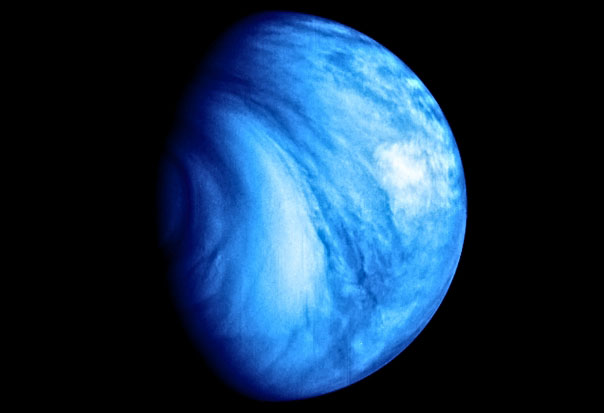
One of the most hotly debated topics of late in the astrobiological community has been whether or not life can exist on Venus - specifically in its cloud layers, some of which have some of the most Earth-like conditions anywhere in the solar system, at least in terms of pressure and temperature. A new paper from a team of American researchers has just added fuel to that debate by reanalyzing data from the Pioneer mission to Venus NASA launched in the 70s Đ and finding that Venus' clouds are primarily made out of water.
Scientists Confirm Massive Underground Tunnels on Venus Futurism - September 23, 2025
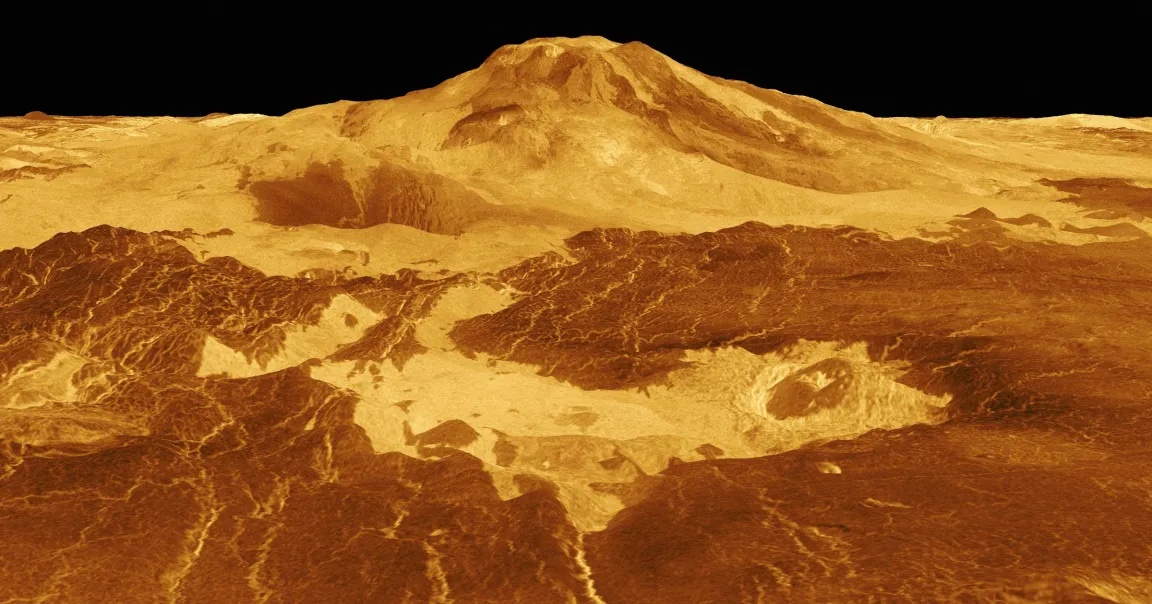
It has been suggested that lava tubes - underground tunnels carved out by molten rock - might be on Venus, and now we have direct evidence that this is the case New Scientist - September 23, 2025
We now know for sure that massive underground tunnels, carved by lava, exist on Venus - and they are surprisingly wide and different from those on any other planet. It is uncontroversial that lava tubes - underground tunnels carved out by molten rock - exist on Earth, the moon and Mars. Smaller planets with low gravity tend to form more cavernous tubes, in part because the rock walls are less likely to collapse with weaker gravity. On the moon, for instance, the tubes are so large that scientists have proposed using them as live-in shelters for astronauts, providing shielding from the harsh solar wind.
Venus May Be More Earth-Like Than We Thought - And It's Still Moving Science Alert - May 15, 2025

A new delve into archival data collected decades ago suggests that the alien planet has ongoing tectonic-like processes that are deforming its surface and recycling its crust. If this is the case, then the large, round features on the Venusian surface called coronae may be the key that unlocks our understanding of the planet's interior processes.
Could Venus host life? The Venus life equation can help us find out PhysOrg - March 29, 2025

Despite its inhospitable nature, Venus is a terrestrial planet that resembles our own in size, mass, and bulk composition. Venus and Earth are both in the habitable zone, though some say Venus only gets in on a technicality. Somehow, their climates diverged dramatically, with Earth remaining habitable and Venus suffering an extreme greenhouse effect. So, Venus has something to tell us about how rocky planets that are similar in so many ways can be vastly different in others.
Oxygen Has Been Directly Detected in Venus' Dayside Atmosphere Science Alert - November 8, 2023
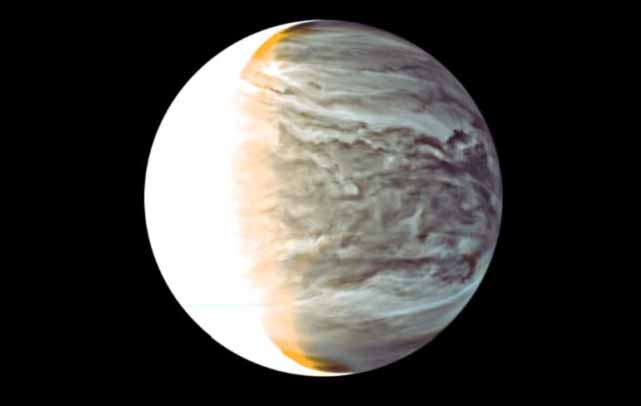
Astronomers peering at the atmosphere of Venus have directly detected clear signs of atomic oxygen in daylight, hanging about above the planet's toxic clouds.
Is there life floating in the clouds of Venus? BBC - September 14, 2020
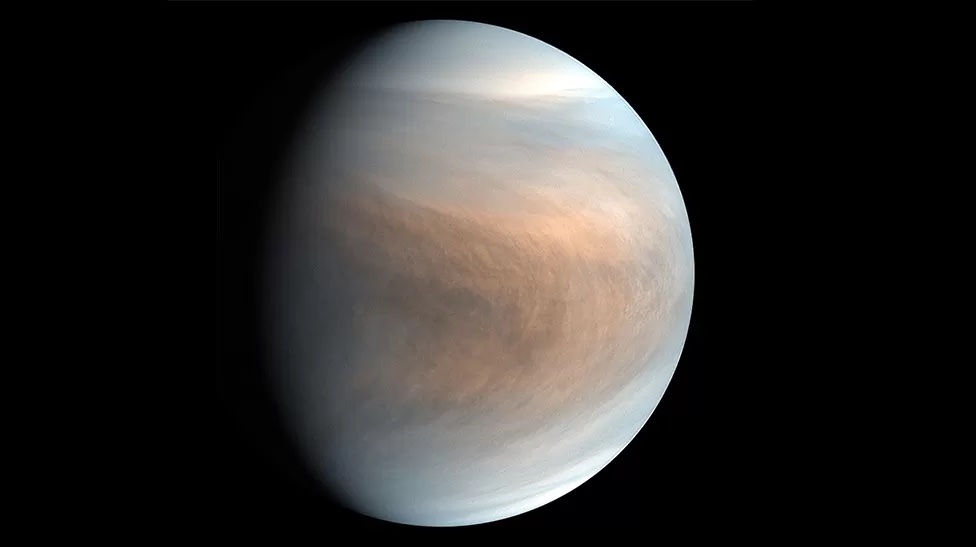
It's an extraordinary possibility - the idea that living organisms are floating in the clouds of Planet Venus. But this is what astronomers are now considering after detecting a gas in the atmosphere they can't explain. That gas is phosphine - a molecule made up of one phosphorus atom and three hydrogen atoms. On Earth, phosphine is associated with life, with microbes living in the guts of animals like penguins, or in oxygen-poor environments such as swamps. For sure, you can make it industrially, but there are no factories on Venus; and there are certainly no penguins. So why is this gas there, 50km up from the planet's surface? Prof Jane Greaves, from Cardiff University, UK and colleagues are asking just this question.
Volcanoes on Venus: 37 active coronae are found on the surface of Earth's sister planet - overturning the theory it is an inactive world Daily Mail - July 25, 2020
Venus is geologically active and has as many as 37 recently 'live' volcanic structures called coronae that are dotted across its surface, according to astrogeologists. This overturns a previous theory that these 'volcanic structures' - first spotted through satellite observations of the planet - were long extinct. Researchers from the University of Maryland and the Institute of Geophysics, Zurich, created 3D models to investigate whether the coronae could be geologically active. They found that rather than coronae being formed from geological activity more than 500 million years ago, they come from currently active processes. The ring-like structures are formed when hot material from deep inside the planet rises through the mantle and erupts through the crust. This discovery 'significantly changes' the way in which scientists will view the second planet from the Sun in future, according to the team behind the research.
We Just Got Even More Evidence That Venus Has Surprisingly Active Volcanoes Science Alert - July 23, 2020
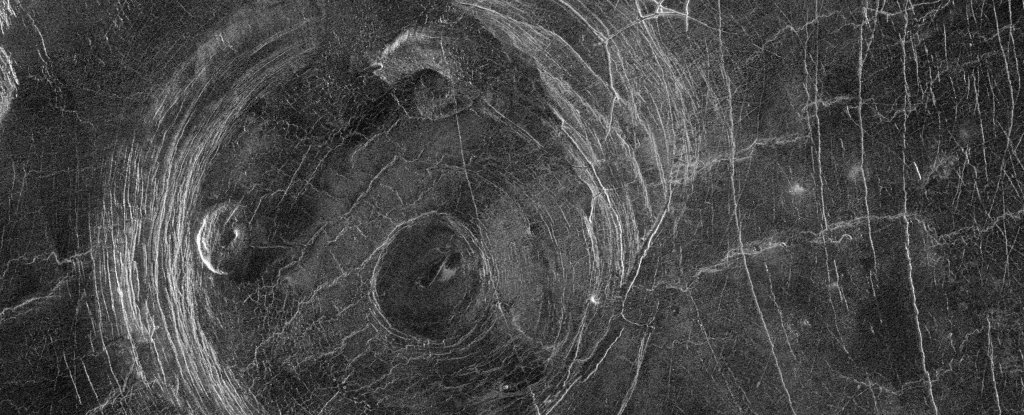
The planet Venus is scorching hot beneath its suffocatingly thick atmosphere, much of its surface shaped by the surges and flows of volcanic activity. Nevertheless, planetary geologists have been unable to find hard evidence that the planet remains volcanically active.
Bizarre Symmetrical Streaks Spied in Atmosphere of Venus Space.com - February 21, 2019
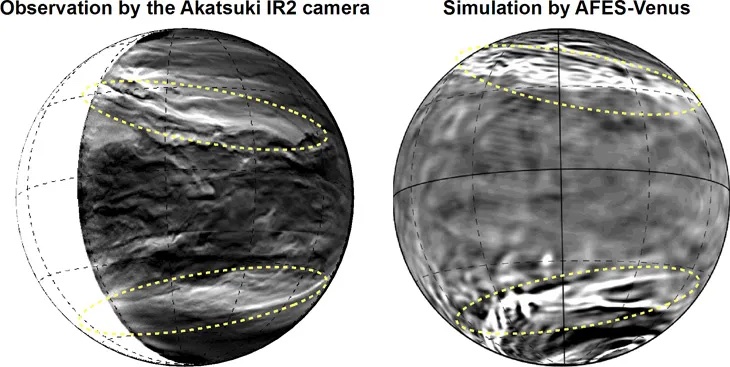
New pictures show two symmetrical streaks hiding in the sulfuric acid clouds close to the surface of Venus. The Japanese Akatsuki spacecraft spotted the twin phenomena in Venus' northern and southern hemispheres. Each streak is roughly 6,200 miles (10,000 kilometers) across. That's more than double the distance between San Francisco and New York City.
Cylindrical Mountains on Venus NASA - October 16, 2016
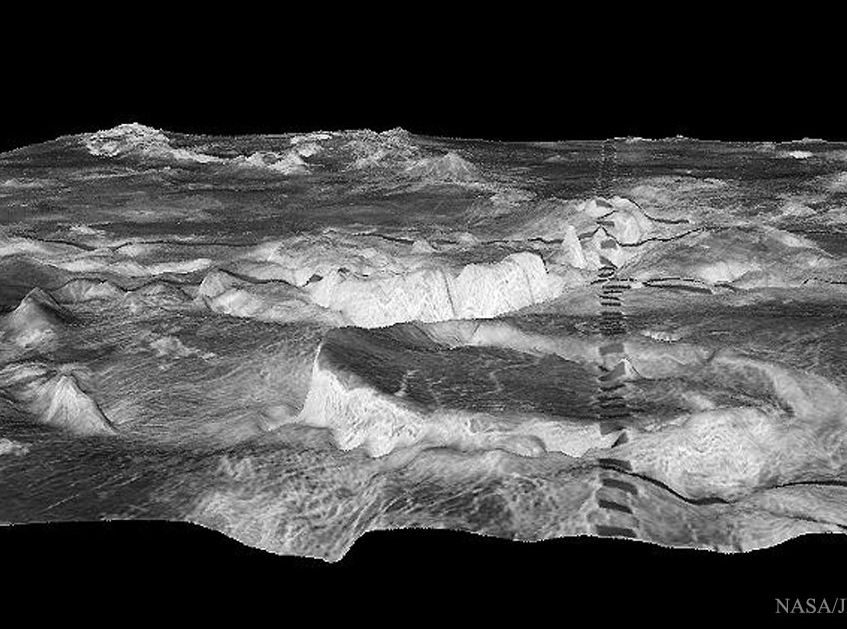
Explanation: What could cause a huge cylindrical mountain to rise from the surface of Venus? Such features that occur on Venus are known as coronas. Pictured here in the foreground is 500-kilometer wide Atete Corona found in a region of Venus known as the Galindo. The featured image was created by combining multiple radar maps of the region to form a computer-generated three-dimensional perspective. The series of dark rectangles that cross the image from top to bottom were created by the imaging procedure and are not real. The origin of massive coronas remains a topic of research although speculation holds they result from volcanism. Studying Venusian coronas help scientists better understand the inner structure of both Venus and Earth.
On Venus, Rainbow-Like 'Glory' Seen for 1st Time (Photos) Live Science - March 26, 2014
Scientists have captured shimmering rainbow colors above Venus for the first time using a European spacecraft currently orbiting the cloud-covered planet. The new Venus photos mark the first time that a rainbow-like "glory" has been photographed on another world besides the Earth, officials with the European Space Agency (ESA) announced this month. The phenomenon also pointed to a mystery in the hothouse planet's atmosphere, they added. ESA's Venus Express spacecraft captured a 746-mile (1,200 kilometer) glory on Feb. 24, 2011 that happened when the sun shone on sulfuric acid droplets atop the atmosphere. The phenomenon was spotted about 43 miles (70 kilometers) above Venus' surface after researchers took pictures of the clouds with the sun directly behind the spacecraft.
Strange Discovery: Giant Dust Ring Found Near Venus Orbit Live Science - November 21, 2013
Scientists have found a huge, diffuse ring of dust near the orbit of Venus, marking the second time such a structure has been discovered in our solar system. The dust ring stretches about 137 million miles (220 million kilometers) from end to end, though it's just 10 percent denser than the background cloud that pervades interplanetary space and produces the glow known as zodiacal light, researchers said.
Venus springs ozone layer surprise BBC - October 8, 2011
Scientists have discovered that Venus has an ozone layer. The thin layer, which is hundred of times less dense than the Earth's, was discovered by the European Space Agency's Venus Express craft, researchers report in the journal Icarus. Until now, ozone layers have only been detected in the atmospheres of Earth and Mars. The find could help astronomers refine their hunt for life on other planets. The European spacecraft spied the ozone layer when focusing on stars through Venus' atmosphere.
The shape-shifting southern vortex of Venus PhysOrg - April 7, 2011
New analysis of images taken by ESA's Venus Express orbiter has revealed surprising details about the remarkable, shape-shifting collar of clouds that swirls around the planet's South Pole. This fast-moving feature is all the more surprising since its centre of rotation is typically offset from the geographical pole.
Venus' Once Molten Surface NASA August 1, 2010
If you could look across Venus with radar eyes, what might you see? This computer reconstruction of the surface of Venus was created from data from the Magellan spacecraft. Magellan orbited Venus and used radar to map our neighboring planet's surface between 1990 and 1994. Magellan found many interesting surface features, including the large circular domes, typically 25-kilometers across, that are depicted above. Volcanism is thought to have created the domes, although the precise mechanism remains unknown. Venus' surface is so hot and hostile that no surface probe has lasted more than a few minutes.
Venus Express adds evidence for atmospheric water loss on Earth's Twin PhysOrg - September 16, 2009
Observations by the European Space Agency's Venus Express mission have provided strong new evidence that the solar wind has stripped away significant quantities of water from EarthŐs twin planet. The data also shed new light on the transfer of trace gases in the Venusian atmosphere and wind patterns. Previous studies have shown that East-West wind speeds are very high, reaching 400km/h in the upper clouds at equatorial latitudes and 230 km/h in the lower cloud at tropical latitudes. However, the new analysis also shows that there is almost no wind in meridional (North-South) directions between tropical and subpolar latitudes in the lower cloud, which is in contrast to wind speeds of around 35 km/h in the upper clouds flowing from tropics to the pole transporting heat. Intriguingly, particular structures in the lower cloud layer may still travel North and South in this region with significant velocities of up to 40 km/h.
Experts puzzled by spot on Venus BBC - August 2, 2009
Astronomers are puzzled by a strange bright spot which has appeared in the clouds of Venus. The spot was first identified by an amateur astronomer on 19 July and was later confirmed by the European Space Agency's Venus Express spacecraft. Data from the European probe suggests the spot appeared at least four days before it was spotted from Earth. The bright spot has since started to expand, being spread by winds in Venus's thick atmosphere. Scientists are unsure as to what caused the bright spot tens of kilometres up. However, a volcanic eruption is a possibility.
Probe hints at past Venus ocean BBC - July 14, 2009
A European probe orbiting Venus has new data that indicates the planet may once had a lot of water on its surface and even had a system of plate tectonics. The Venus Express craft has returned infrared maps that show heat variations among the surface rocks.
Scientists say some highland areas are slightly cooler, suggesting they have a different composition. The German researchers working on the mission say these rocks could be akin to the continental rocks seen on Earth. Such rocks would be granitic in nature. On our own planet, granites are made during the process of rock recycling that goes on at the edges of the great geologic plates that cover the Earth. At the boundaries of these plates, ancient rock is pulled deep into the planet, reworked with water and then re-surfaced at volcanoes.
Where Did Venus's Water Go? Science Daily - December 19, 2008
The spacecraft's magnetometer instrument (MAG) detected the unmistakable signature of hydrogen gas being stripped from the day-side. ŇThis is a process that was believed to be happening at Venus but this is the first time we measured it,Ó says Magda Delva, Austrian Academy of Sciences, Graz, who leads the investigation. Thanks to its carefully chosen orbit, Venus Express is strategically positioned to investigate this process; the spacecraft travels in a highly elliptical path sweeping over the poles of the planet. Water is a key molecule on Earth because it makes life possible. With Earth and Venus approximately the same size, and having formed at the same time, astronomers believe that both planets likely began with similar amounts of the precious liquid. Today, however, the proportions on each planet are extremely different. EarthŐs atmosphere and oceans contain 100 000 times the total amount of water on Venus. In spite of the low concentration of water on Venus Delva and colleagues found that some 2x1024 hydrogen nuclei, a constituent atom of the water molecule, were being lost every second from Venus's day-side.
Puzzling 'Eye Of A Hurricane' On Venus Science Daily - March 17, 2008
Venus Express has constantly been observing the south pole of Venus and has found it to be surprisingly fickle. An enormous structure with a central part that looks like the eye of a hurricane, morphs and changes shape within a matter of days, leaving scientists puzzled.
Did A Mega-collision Alter Venus? Science Daily - February 28, 2008
A mega-collision between two large embryonic planets could have created Venus as we know it, according to a new paper by a Cardiff University scientist.
Mysterious Acid Haze on Venus NASA - February 26, 2008
Why did an acidic haze spread across Venus? The unusual clouds were discovered last July by ESA's robotic Venus Express spacecraft currently orbiting Venus. The bright and smooth haze was found by Venus Express to be rich in sulfuric acid, created when an unknown process lifted water vapor and sulphur dioxide from lower levels into Venus' upper atmosphere. There, sunlight broke these molecules apart and some of them recombined into the volatile sulfuric acid. Over the course of just a few days last July, the smooth acidic clouds spread from the South Pole of Venus across half the planet. The above false-color picture of Venus was taken last July 23rd in ultraviolet light, and shows the unusual haze as relatively smooth regions across the image bottom. The cause of the dark streaks in the clouds is also not yet understood and is being researched.
Venus offers Earth climate clues BBC - November 29, 2007
Data from a European probe orbiting Venus paints a picture of a planet that may once have been like Earth, but later evolved in a very different way. Venus has undergone runaway greenhouse warming, where trapped solar radiation has heated the surface to an average temperature of 467°C (872°F).
New Isotope Molecule May Add To Venus' Greenhouse Effect Science Daily - October 12, 2007
Planetary scientists on both sides of the Atlantic have tracked down a rare molecule in the atmospheres of both Mars and Venus. The molecule, an exotic form of carbon dioxide, could affect the way the greenhouse mechanism works on Venus.
Swirling Clouds Over the South Pole of Venus NASA - May 1, 2007
What's happening over the South Pole of Venus? To find out, scientists sent the robot Venus Express spacecraft now orbiting Venus directly over the lower spin axis of Earth's overheated twin. Venus Express confirmed there a spectacular massive swirling storm system with similarities to the vortex recently imaged over Saturn's South Pole. The above composite image in infrared light features Venus' daytime side on the left, shining primarily by reflected sunlight, and nighttime side on the right, shining primarily by thermal light. A Venusian polar vortex is visible as the small circular feature near the center of the thermal infrared image pictured on the right. Close inspection of other South Pole images unexpectedly showed a second vortex, meaning that the unusual swirling clouds are like an Earth-hurricane that has two eyes. Why a double vortex has formed is now a topic of research. The above image was taken last year, and more recent images from Venus Express are being processed that have as much as 100 times more detail.
Probe peers into Venusian secrets BBC - October 12, 2006
Venus is an enigma, wrapped in a mystery, inside a dense cloud of carbon dioxide (CO2). But a suite of orbiting instruments is proving its ability to penetrate the thick atmosphere and create a new and dynamic picture of Earth's sister planet.
Scientists at the Division of Planetary Sciences meeting in Pasadena, California, this week said that data streaming from the Venus Express probe had provided unprecedented detail of the Venusian atmosphere and the first-ever peek at its lower strata. They hope the spacecraft will help answer fundamental questions about the planet's atmospheric composition and dynamics, as well as solve key Venus puzzles: what drives its "super-rotation"; are its volcanoes active; and just what is the strange ultraviolet-absorbing substance swirling at the cloud tops?
Planet Venus: Earth's 'evil twin' BBC - November 7, 2005
The Babylonians called it "Ishtar". To the Mayans, it was known as "Chak ek", which translates as "great star".
Some ancient astronomers believed it was two separate objects: a "morning star" and an "evening star". Venus is the brightest object in the sky except for the Sun and Moon. As such, the second planet from the Sun has fascinated humankind for millennia. Europe's Venus Express spacecraft made its rendezvous with our nearest planetary neighbor in April to study it from orbit. The mission aims to shed light on an enduring mystery about this world: how a planet so similar to our own in size, mass, and composition has evolved so differently over the last 4.6 billion years.
Venus has 'heavy metal mountains' BBC - November 2003
The highlands of Venus are covered by a heavy metal "frost", say planetary scientists from Washington University.
Because it is hot enough to melt lead at the surface, metals vaporize and condense at cooler, higher elevations. This may explain why radar observations made by orbiting spacecraft show that the highlands are highly reflective. Detailed calculations, to be published in the journal Icarus, suggest that lead and bismuth are to blame for giving Venus its bright, metallic skin. Frequently seen as a brilliant point of light in the evening or morning sky, Venus has been identified with beauty by many cultures. But the truth is somewhat different.
The ancient Sumerians and Babylonians called Venus Dil-bat in Akkadia it was the special star of the mother-god Ishtar. One of the brightest objects in the sky, Venus has been known since prehistoric times and has had a significant impact on human culture from the earliest days. It is described in Babylonian cuneiform texts such as the Venus tablet of Ammisaduqa, which relates observations that possibly date from 1600 BC. The Babylonians named the planet Ishtar (Sumerian Inanna), the personification of womanhood, and goddess of love. One of the oldest surviving astronomical documents, from the Babylonian library of Ashurbanipal around 1600 BC, is a 21-year record of the appearances of Venus (which the early Babylonians called Nindaranna).
The Maasai people named the planet Kileken, and have an oral tradition about it called The Orphan Boy. In western astrology, derived from its historical connotation with goddesses of femininity and love, Venus is held to influence those aspects of human life.
Ancient China -- Early Chinese astronomers called Venus Tai-pe, or the "beautiful white one". Modern Chinese, Korean, Japanese and Vietnamese cultures refer to the planet literally as the metal star (Chinese), based on the Five elements. Lakotan spirituality refers to Venus as the daybreak star, and associates it with the last stage of life and wisdom.
India -- In Indian Vedic astrology, Venus is known as Shukra (Hindi:, meaning "clear, pure" or "brightness, clearness" in Sanskrit. One of the nine Navagraha, it is held to affect wealth, pleasure and reproduction; it was the son of Bhrgu and Ushana, preceptor of the Daityas, and guru of the Asuras.
Ancient Egyptians believed Venus to be two separate bodies and knew the morning star as Tioumoutiri and the evening star as Ouaiti.
Ancient Greeks thought that the evening and morning appearances of Venus represented two different objects, calling it Hesperus when it appeared in the western evening sky and Phosphorus when it appeared in the eastern morning sky. They eventually came to recognize that both objects were the same planet; Pythagoras is given credit for this realization. In the 4th century BC, Heraclides Ponticus proposed that both Venus and Mercury orbited the Sun rather than Earth.
Ancient Romans would later name the planet in honor of their goddess of love, Venus, whereas the Greeks used the name of her Greek counterpart, Aphrodite (Phoenician Astarte).
Ancient Hebrews Knew Venus as Noga ("shining"), Helel ("bright"), Ayeleth-ha-Shakhar ("deer of the dawn") and Kochav-ha-'Erev ("star of the evening").
Venus was important to the Maya civilization, who developed a religious calendar based in part upon its motions, and held the motions of Venus to determine the propitious time for events such as war. Venus was considered the most important celestial body observed by the Maya, who called it Chak ek, "the Great Star", possibly more important even than the Sun. The Mayans monitored the movements of Venus closely and observed it in daytime. The positions of Venus and other planets were thought to influence life on Earth, so Maya and other ancient Mesoamerican cultures timed wars and other important events based on their observations. In the Dresden Codex, the Maya included an almanac showing Venus's full cycle, in five sets of 584 days each (approximately eight years), after which the patterns repeated (since Venus has a synodic period of 583.92 days). 2012
Australia:
Venus is important in many Australian aboriginal cultures, such as that of the Yolngu people in Northern Australia. The Yolngu gather after sunset to await the rising of Venus, which they call Barnumbirr. As she approaches, in the early hours before dawn, she draws behind her a rope of light attached to the Earth, and along this rope, with the aid of a richly decorated "Morning Star Pole", the people are able to communicate with their dead loved ones, showing that they still love and remember them. Barnumbirr is also an important creator-spirit in the Dreaming, and "sang" much of the country into life
Venus rules our values and sense of appreciation. When we appraise or appreciate something, whether another person or a new car, this is Venus at work. Venus describes how we love and what we want to be loved for. Venus is a key to relationships, pleasure, art and beauty.

Venus rules Taurus

In Greek mythology, Aphrodite was the goddess of love (equivalent to the Roman Venus, Egyptian Goddess Isis, the Phoenician Astarte and the Babylonian Ishtar). She is known as the Daughter of Heaven and Sea, the child of Uranus and Gaia. Her story tells of fertility, love and pleasure. Venus is the goddess of Love and Beauty. She along with her son Cupid (Eros) became a metaphor for sexual love. Venus represents the feminine aspect in all of us. She is the creational Earth Mother. Often seen as the bright, silvery morning or evening star, and is the brightest object in the sky after the sun and the moon. She is said to be either a daughter of Zeus or to have sprung from the foam of the sea.
There are two version of her birth.
In the second version by Homer, she was known as the daughter of Zeus and the Oceanid Dione. The Cherubs Version.
She was married to Hephaestus (Vulcan) but had numerous affairs with gods and mortals, the most notorious of these, the goddess' long affair with Ares (Mars) god of war. She was the mother of Eros (Cupid), Deimus (Fear), Phobus (Panic) and Harmonia, wife of Cadmus. One of her mortal son, was Aeneas, by her lover was Anchises, king of Dardania. Anchises was crippled by thunderbolt from Zeus, when he revealed that he made love to the goddess. She supported the Trojans during the war, not only because Paris awarded the apple to her as the fairest, but that Aeneas also fought with the Trojans. She tried to rescue her son, when Diomedes wounded him. Diomedes also wounded her and drove her off the battlefield.
Her epithets were Acidalia, Anadyomene (born to the sea), Cyprian, Cypris, Cythereia, Eriboea (Periboea), Erycina, Euploios (fair voyage), Paphia (sexual love), Pelagia, and Pontia.
Her favorite haunts were Cyprus and Cythera. Aphrodite favorite animals were the dove, sparrow, swallow, swan and turtle.
She was the unfaithful wife of Hephaestus, the god of fire, and the mother of Eros. Aphrodite surpassed all the other goddesses in beauty, and hence received the prize of beauty from Paris. She likewise had the power of granting beauty and invincible charm to others.
In the vegetable kingdom the myrtle, rose, apple, and poppy, among others, were sacred to Aphrodite, as,in the animal world, were the sparrow, dove, swan, and swallow.
Venus married and bore children but did not stay focused on her home affairs. In fact, she concentrated almost completely on her extramarital affairs. Her many lovers include Aries, the God of War, and the handsome Adonis.
The goddess loved to pamper herself and cultivate her beauty. Her symbol represents the hand-held vanity mirror that Venus used to admire her beauty. Truly, Venus has become the symbol for femininity itself.
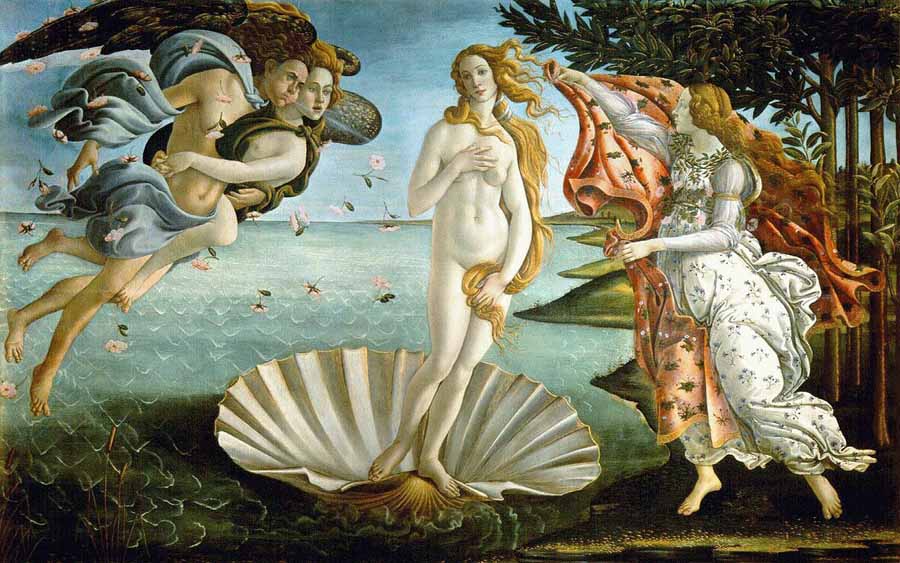
The Birth Of Venus by Sandro Botticelli - 1485-86

Venus - Aphrodite - playing one day with her boy Cupid (Eros), wounded her bosom with one of his arrows. She pushed him away, but the wound was deeper than she thought.
Before it healed she beheld Adonis, and was captivated with him. She no longer took any interest in her favourite resorts - Paphos, and Cnidos, and Amathos, rich in metals.
She absented herself even from heaven, for Adonis was dearer to her than heaven. Him she followed and bore him company. She who used to love to recline in the shade, with no care but to cultivate her charms, now rambles through the woods and over the hills, dressed like the huntress Diana; and calls her dogs, and chases hares and stags, or other game that it is safe to hunt, but keeps clear of the wolves and bears, reeking with the slaughter of the herd.
She charged Adonis, too, to beware of such dangerous animals. "Be brave towards the timid," said she; "courage against the courageous is not safe. Beware how you expose yourself to danger and put my happiness to risk. Attack not the beasts that Nature has armed with weapons. I do not value your glory so high as to consent to purchase it by such exposure. Your youth, and the beauty that charms Venus, will not touch the hearts of lions and bristly boars. Think of their terrible claws and prodigious strength! I hate the whole race of them. Do you ask me why?"
Then she told him the story of Atalanta and Hippomenes, who were changed into lions for their ingratitude to her.
Having given him this warning, she mounted her chariot drawn by swans, and drove away through the air. But Adonis was too noble to heed such counsels.
The dogs had roused a wild boar from his lair, and the youth threw his spear and wounded the animal with sidelong stroke.The beast drew out the weapon with his jaws, and rushed after Adonis, who turned and ran; but the boar overtook him, and buried his tusks in his side, and stretched him dying upon the plain.
Venus, in her swan-drawn chariot, had not yet reached Cyprus, when she heard coming up through mid-air the groans of her beloved, and turned her white-winged coursers back to Earth.
As she drew near and saw from on high his lifeless body bathed in blood, she alighted and, bending over it, beat her breast and tore her hair.
Reproaching the Fates, she said, "Yet theirs shall be but a partial triumph; memorials of my grief shall endure, and the spectacle of your death, my Adonis, and of my lamentation shall be annually renewed.
Your blood shall be changed into a flower; that consolation none can envy me."
Thus speaking, she sprinkled nectar on the blood; and as they mingled, bubbles rose as in a pool on which raindrops fall, and in an hour's time there sprang up a flower of bloody hue like that of the pomegranate.
But it is short-lived. It is said the wind blows the blossoms open, and afterwards blows the petals away; so it is called Anemone, or Wind Flower, from the cause which assists equally in its production and its decay. Milton alludes to the story of Venus and Adonis in his "Comus: